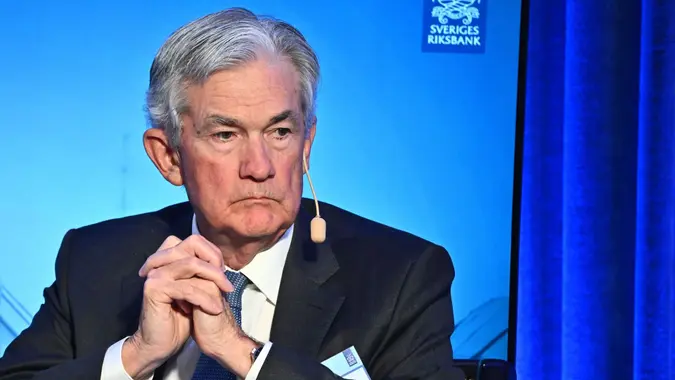Powell Reiterates Need for Fed to Increase Interest Rates in 2023

Commitment to Our Readers
GOBankingRates' editorial team is committed to bringing you unbiased reviews and information. We use data-driven methodologies to evaluate financial products and services - our reviews and ratings are not influenced by advertisers. You can read more about our editorial guidelines and our products and services review methodology.

20 Years
Helping You Live Richer

Reviewed
by Experts

Trusted by
Millions of Readers
In his first public speech of the new year, Federal Reserve Chair Jerome Powell addressed the importance of the central bank being transparent and remaining independent of political pressures. His remarks come amid uncertainty about how much longer the Fed will remain hawkish, and to which degree.
“The case for monetary policy independence lies in the benefits of insulating monetary policy decisions from short-term political considerations,” Powell said on Jan. 10, at the Symposium on Central Bank Independence, Sveriges Riksbank, in Stockholm, according to his prepared remarks. “Price stability is the bedrock of a healthy economy and provides the public with immeasurable benefits over time.”
Powell also acknowledged that restoring price stability when inflation is high by raising interest rates to slow the economy, can be unpopular.
“The absence of direct political control over our decisions allows us to take these necessary measures without considering short-term political factors. I believe that the benefits of independent monetary policy in the U.S. context are well understood and broadly accepted,” he added.
The Chair did not provide details about the future of the monetary policy in his speech, which came on the heels of the Fed’s release of the minutes of its Dec. 13-14 Federal Open Market Committee (FOMC) meeting on Jan. 4.
In the minutes, the Fed said that its restrictive policy stance would need to be maintained until the incoming data provided confidence that inflation was on a sustained downward path to 2%, “which was likely to take some time,” as GOBankingRates previously reported.
“In view of the persistent and unacceptably high level of inflation, several participants commented that historical experience cautioned against prematurely loosening monetary policy,” according to the Jan. 4 minutes.
Finally, Powell said in Stockholm that the Fed should stick to its “knitting” and “not wander off to pursue perceived social benefits that are not tightly linked to our statutory goals and authorities,” such as climate change.
“Fed Chair Powell’s speech at the symposium on central bank independence did not give an update on the economy or monetary policy. He noted, we are not, and will not be a “climate policymaker,” said Edward Moya, Senior Market Analyst, The Americas OANDA. “Powell doesn’t want to compromise their independence by getting entrenched with the climate change debate.”
At the December meeting, in a move that was widely anticipated, the Fed Reserve unanimously raised interest rates by half a point for its last meeting of the year. This latest, smallest hike followed four consecutive 75 bps hikes
The Fed’s next rate decision will be on Feb. 1.
 Written by
Written by 

























